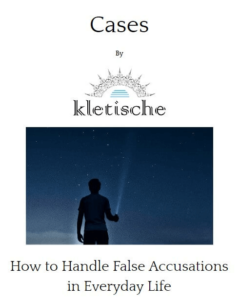Contents:
This article is about being falsely accused of something you did not do.
Knowing what to do when you are falsely accused is important. Your words and actions can either aid others in aligning their interpretation with reality or drive it even further into delusion.
The process can feel like psychological torture. Such instances represent reality not aligning with your version of it inside your mind; with you being the subject of the negative gaze of accusers and onlookers. Depending on what you are falsely accused of, the intensity of your experience can vary based on its specifics.
This article will focus on accusations which we experience in our day-to-day lives and is not intended to be legal advice in any form.
The first thing you need to remember in being falsely accused is that if there are no witnesses, nobody will be empathetic towards your situation until you are proven innocent. You may feel alone in this bout against misconception, and the battle towards clearing your name is a lonely one. It is filled with torture, doubt, and depression.
If you find yourself alone without anybody’s shoulder to lean against, know that you are not. This is written from a place of empathy with a focus on helping you. So stay strong, limit emotional responses, and do not fall victim to the pressure of it all.
Find Out What Led to the Accusation
Your first task is to find out how the decisions were made against you committing something which you did not do. Collect all evidence which your accusers drew their conclusions from. Do not blame and react to your accusers in a negative manner. These are people who simply followed what they thought was evidence against you toward an opinion which they now believe. You must not assume that all false accusations are malicious in their nature, until you have the capacity to prove that fact.
Know what was said, what was seen, what was collected, and what was assumed.
Be calm in your collection of evidence, as you will be in direct conversation with your accusers. Collect from them everything that led to you being falsely accused. The changing of their opinion depends just as much on what style you do it in as it does on how powerful your factual argument happens to be.
Be calm, understanding, and put yourself in your accusers’ shoes. More likely than not, the evidence they have against you will be powerful enough to change minds, so acknowledge and respect its power. Do not simply dismiss anything that you hear. Prove it wrong with logical reason and factual evidence.
Make it a habit to take even the smallest false accusations seriously.
Rather than dismissing them and hoping they’d go away, ensure you’ve explored and snipped all the loose ends in people’s interpretation of the facts.
Once you have noted and understood the case against you, it would then be your turn to present the case against your guilt. Ensure you do this only once you have collected all of the arguments for you being guilty.
Get the document of cases / examples which demonstrate the methods outlined in this article: |
|
A Serious Consideration on Your Part Includes Sometimes Agreeing With Your Accusers
Some of the arguments against you will contain truth. When this is the case, acknowledge, and admit to specific things being true in your accusers’ arguments. Doing so will bring more benefit than you’d think. Your audience will notice that you are willing to be honest without trying to save face. Though some points of their evidence against you may be true, the outcome of their mental trial of you can still very much be false. People reach for finality, and the collection of evidence which seemingly points one way does well to motivate them to reach for conclusions which are not there.
When disproving the conclusions that your accusers have drawn in an effort to find you guilty, start a running list of things in their case which are true and which aren’t.
- For everything that is not true, try to have evidence against it.
- For everything that is true, be willing to admit it but draw conclusive barriers between what is true and what assumptions were made based on those truthful aspects.
- Figure out the pathway your accusers took from specific, smaller truths, all the way to finding you guilty of a bigger deed. Show empathy toward those who are incorrectly accusing you by seriously considering which wrong intellectual turns they made while attempting to blame you.
- Disprove any correlation that specific, true, pieces evidence have with the final assumed accusation by presenting the evidence you have against those assumptions / reaches.
- Explain the psychological fallacies that your accusers fell victim to in their effort to label you as guilty (explained in detail in the later section).
Disproving false accusations is an exercise of educating your accusers as much as it is defending yourself.
Be empathetic to your accusers rather than argumentative. Understand that inside their minds, they’ve gotten everything right, and proving otherwise will include a lot of re-educating. Show your accusers they are wrong without saying it explicitly.
Begin mentioning the holes in their argument with the confidence of the truth backing up what you say. As if showing that you understand the pathways they took, start to explain that you know exactly what they thought when they interpreted the limited evidence against you. Explain where they made sense in their analysis and where they made jumps.
By being truthful in where they did a good job of analyzing, you’ll massage them to be more open to understanding where they were wrong. Explain why the evidence which they presented does not necessarily lead to the larger accusations being true.
Get the document of cases / examples which demonstrate the methods outlined in this article: |
|
|
See the details of the downloadable document here.
|
The Socratic Method: Calling Out Assumptions Involves Asking Good Questions
Explaining why certain conclusions were drawn requires you to have a detailed understanding of the assumptions your accusers made in the particular case you’re defending yourself in.
Discretely label, and make known, all the assumptions at play. Sprinkle them into a recital of the thought processes that played out in your accusers’ minds. By being a balanced, objective, empathetic party in the matter, you’ll increase the chances of opinions changing around you.
A primary concern for you, should be to publicize the fact that you’re caught up on the detailed perspective of your accusers. The fact that you are, will make your rebuttals more powerful.
Supplement their opinions changing with a set of perfectly placed questions.
Ensure that the questions you pose to your accusers entrap them with answers that go against the accusation which they made themselves. These questions should be similar to questions they would have asked themselves if they were conducting a proper investigation into your guilt. These questions however, would result in answers which disprove certain conclusions they’ve drawn. It will be clear to you how to form questions such as these while knowing the details of your particular case.
For instance if someone at work falsely accuses you of taking their lunch from the fridge, you’d be able to ask a few questions which they didn’t take the time to think through.
- “Why would I have gone downstairs to buy lunch if I took yours?”
- “Are you assuming this simply because someone saw me in the lunchroom today?”
- “Do you know about everyone who was in the lunchroom today? What makes me stand out?”
- “It seems you’re assuming that since I never bring lunch from home, my presence in the lunchroom was suspicious. Is that true?”
etc.
Remember that changing people’s minds is a difficult thing to do. It goes deeper than just presenting evidence against what they say, and it also relies on educating them in a manner which they are accepting toward. Be human about it, and know that you are dealing with other humans who are merely uneducated on the subject. Your calm nature of dissecting all of their evidence will powerfully serve to help your case.
Get the document of cases / examples which demonstrate the methods outlined in this article: |
|
|
See the details of the downloadable document here.
|


